Making Classic Tamales

Now just to be clear, I don’t have to eat the wrapping too, do I? I remember quite clearly asking that question when I was first confronted with non-convenience store tamales. How the heck do you eat these things? It’s a fair question for any inexperienced tamale-eater, since very few foods land on our dinner plates still in the wrapping…unless of course Dad got lazy dishing up the Happy Meals at the kitchen table this week (something you can pretty much count on at our house).
Tamales are members of the “anything goes” family of hand-held foods, along with pasties, pies and sandwiches. Just about anything can go in them. They’re a superior (if somewhat time consuming) way to use leftovers like grilled meats and vegetables, refried beans, cooked or rehydrated fruit…you name it. Soak a few corn husks, whip together a little masa and you’re in business.
Of course there are several more “formal” recipes for tamales, one of which I shall now show you. It’s for classic pork tamales of the kind found in Mexican restaurants all over America. Before we begin I must credit Rick Bayless, a world class chef and all-around great guy, from whom I’ve learned most of what I know about tamales. His recipes have been my inspiration all week. So then, for the filling we’ll need:
2 ounces dried ancho chiles (before rehydration, about 4 large ones)
half a white onion, roughly chopped
3 garlic cloves
1/2 teaspoon fresh ground black pepper
8 ounces pork stew meat (shoulder, say)
1 recipe masa for tamales
about half a package dried corn husks
Begin by placing the corn husks in a large pot. Put in a plate (to weigh them down), cover with water and bring to a simmer. Once the water has been brought to the boil, turn the heat off and let them sit for an hour.
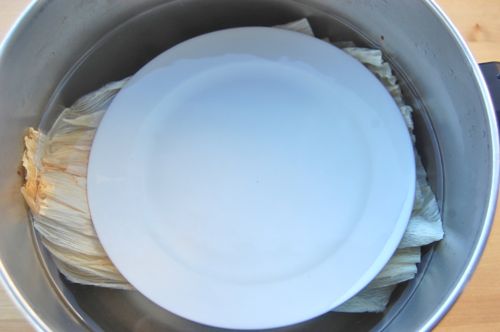
Now then, place the rehydrated chiles, onion, garlic cloves and pepper in a food processor. Add enough water to come most of the way up the ingredients (the exact amount isn’t terribly important).
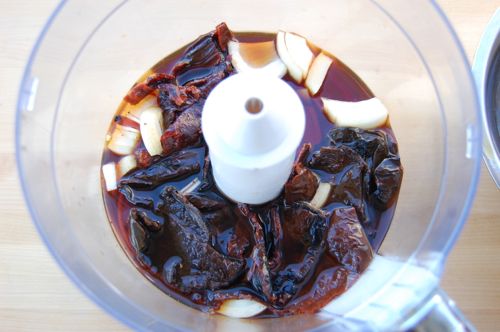
Give it all spin…for maybe a minute.

Now pour the mixture through a medium sieve.
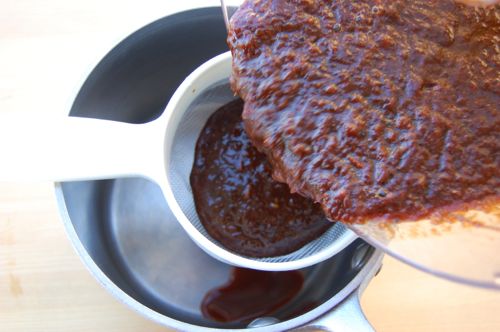
You’ll need to press it through with the back of a spoon. Discard the last couple tablespoons of solids, they’re mostly the tough skin of the anchos. Those peppers — poblanos in their former life — have particularly tough skins.
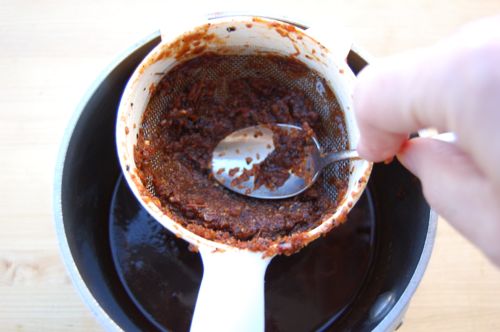
Now add the meat. There should be plenty of sauce to cover them. If not add some water and stir! Simmer all that for a good hour until the meat is very tender. Meanwhile make your masa batter.

Remove the meat from the sauce and pour the sauce into a small bowl. Shred the meat and put it into a separate bowl.

Now for assembly. Select one of the longer corn husks and tear off about a dozen very narrow strips. These will be your ties.

Lay out your shredded pork, the sauce and the ties. A small bowl of water isn’t a half bad idea either. Take one of the husks out of the water and give it a wipe-off with a paper towel.
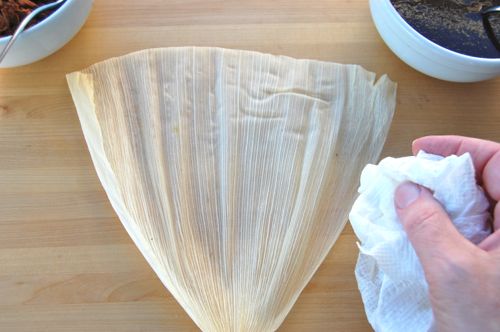
Spoon about 1/4 cup of the masa batter onto the husk, in the center about two thirds of the way toward the top. It’ll be sticky so dip your hand in the water to spread the batter…just gently pat it into a rough square.
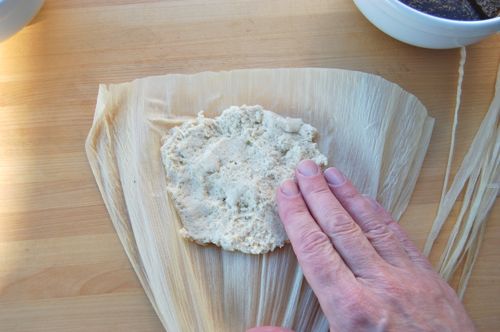
Spoon on a heaping tablespoon or so of the meat, then about a tablespoon of the sauce. Don’t overfill the tamales, since it’s important that the masa enclose the filling (otherwise the sauce will just run right out during cooking).
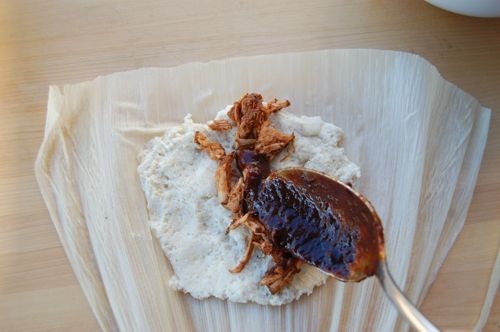
Now to shape. Notice that both my hands are in the photo. Normally they refuse to appear on screen together (bad blood from a past royalty dispute), but both hands have graciously agreed to put aside their differences on this very important occasion. So then, grasp the husk in such a way that your fingertips are positioned at the edges of the filling (on the underside of the husk, of course).
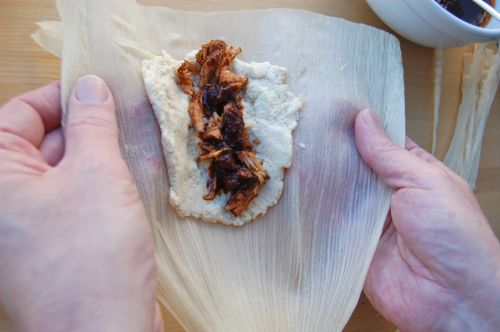
Bring your hands together until your fingertips meet, thus enclosing the filling in the batter.
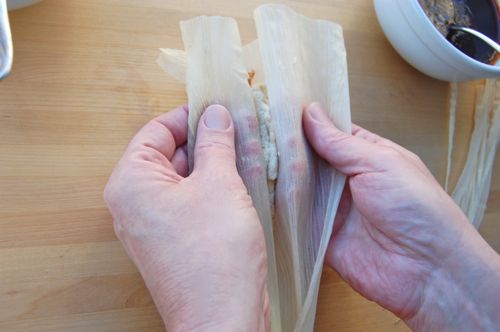
Now flip both of the edges over in the same direction…left or right makes no difference…
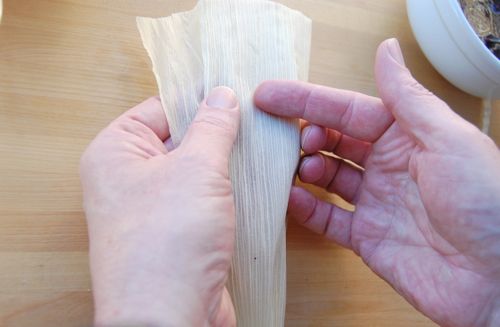
…and wrap them around the tamal.
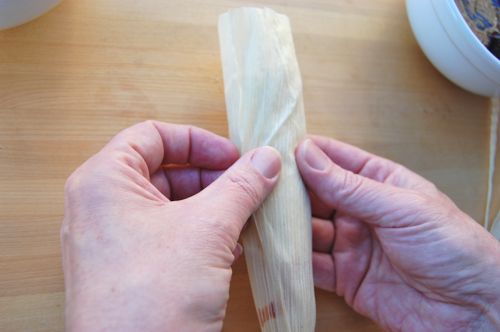
Fold up the bottom of the husk and you’re finished.
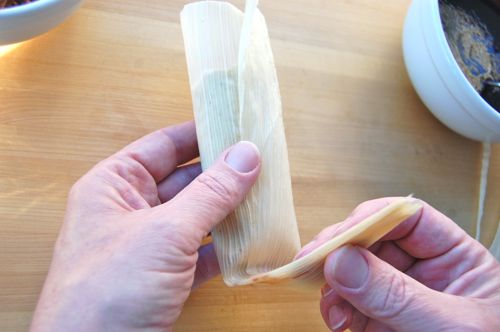
Just tie the tamal closed. Notice I’m down to just one hand again. Sadly my right hand unexpectedly stormed off the set in a huff for who-knows-what reason (puh…talent!). The left hand somehow found a way to soldier on and get the knot tied anyway. That’s what we in “the business” call professionalism.
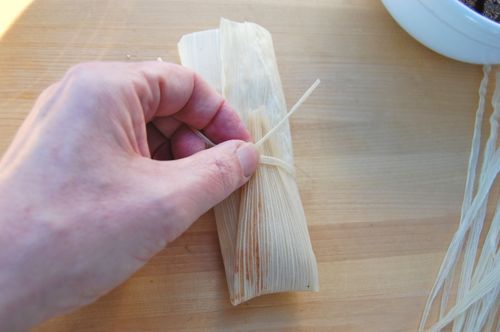
Place the tamales in a steamer and steam them for 75 minutes (if you used fresh masa reduce the time by 15 minutes).
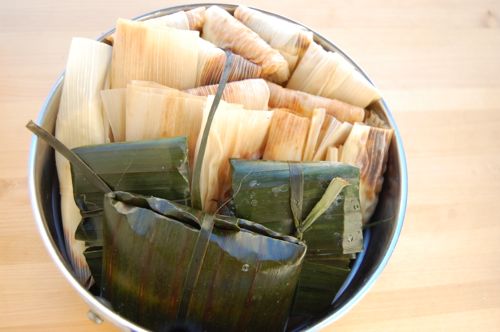
This recipe makes about a dozen tamales. Above I’m using a very small steamer insert. If you don’t have enough tamales to fill your steamer (whether it’s small or large) you can pack in any empty space with spare corn husks, so the tamales don’t fall over while they cook. The true pros use very large steamers and make dozens and dozens at a time.
Once the tamales are done, let them rest about ten minutes off the heat to let the masa firm up. Serve warm…right from the steamer. I should add that they keep very well in the fridge for a few days, and freeze very well. They can be reheated in the steamer for best results. The microwave fine works if you’re in a rush!
God I have not had a proper tamale since I was 13… when we lived in California. I loved both the pork and the raisin dessert ones. If I can ever get the ingredients here in sweden I’m going to recall this post!
It’ll be here! 😉
– Joe
But you forgot to tell us how the heck to eat these things!! (In truth, I have always wondered.)
These posts have been fascinating reading, even though I can pretty safely say I will never try this unless there’s a credible vegetarian version, which I doubt. (Pork and lard just don’t go over well within the framework of Jewish dietary law, what can I say.) But I’ve enjoyed the reading tremendously. A few weeks ago (even before you started the tamale stuff, I guess great minds think alike) I bought a bunch of ancho chiles after I started reading one of Rick Bayless’s cookbooks. I decided my ignorance of Mexican cuisine was inexcusable. He has a basic sauce with anchos that I realized I absolutely must make, and I recognize the method in your posts. I’ll be trying it this weekend.
So thanks for all that information. (And the photos. And the humor!)
Hey, that’s what Crisco was created for! Or you can use butter. As for fillings, grilled veggies or mushrooms are fabulous. You can make pork-free tamales with ease. Get to it, Chana! 😉
– Joe
Oh, and as for how you eat them…unwrap, pick up, bite. Or use a knife and fork, which is perfectly legal.
My friend and I will get together and make a huge batch of these, we ran out of filling a few times ago and mixed up black beans mixed with fresh onion, red pepper, lime and corn relish to use up the rest of the masa. We had also put a nectarine in the chili sauce to counter the habanero’s heat. They were better than any of the chicken and pork ones and now just make those. I can give a better recipe if you want it.
I also used coconut oil in my masa that time because I was out of lard and liked the subtle sweetness in the dough, but I’m crazy for coconut. 🙂
Those are some wild improvisations, Audi, but I bet the tamales were delicious! Sure, I’d be curious for a recipe…
– Joe
This reminds me of a south indian delicacy; We wrap it in banana leaves and make it the same way. The chlorophyll from the banana leaves permeates into the stuffing and gives a nice aroma. Is it the same in this case..? Does the husk impart any flavour or essence…?Expecting a lot more of savoury bakes from you.
I’m not sure whether the husks add any extra flavor to the corn or not…my expectation is not. Nothing like banana leaves at any rate! Fascinating that something similar to this is made in India. Thanks Geetha!
– Joe
Oh yes….!, this is so surprising, there is also a fish delicay that is seared with banana leaf. We marinate the fish with spices and chillies and sear them with the leaf intact. You have to eat it to believe it. Besides, I find mexicans share our love for chillies .. 🙂
Wow that sounds good. When am I going to get a dinner invitation, Geetha?
– Joe
Anytime..Mrs JP and the two little missees are invited too.
You can also soak the husk in spices of choice to transfer flavor. I am new to tamale making and read that in a different article.
Thanks, Terri!
– Joe
So this would be a good thing to do with leftover pulled pork? My slow-cooker heavy-on-the-chipotle version anyway?
I think that would be fantastic, actually. For sure!
– Joe
Yummm! My favorite tamales as a kid were filled with green chile & chicken because they were slightly sweet. I haven’t had one in several years, and I was tempted to ask my mother-in-law how to make them around Christmas… Until I found out she will only make them with the meat bone-in. No thanks! I’m going to bookmark this & brave it alone this year for the holidays. Well, not entirely alone… Joe! 🙂
Ha! Thanks Naomi!
– Joe
You say that tamales will last a few days in the fridge. After a few days, what happens to them? For example – if I made some on Sunday for dinner and then made extras for the rest of the week’s lunches… when would I know they were no longer good? Do they get slimey? Does the flavor change? Is it a bacterial issue?
Oh no, there’s no danger involved. Like most cooked foods, tamales will keep for a solid week in the fridge. The flavors are at their best in the next couple of days, but they’ll still be plenty delicious for Friday lunch.
Have fun with them!
– Joe
How about a good mole to go with?
Golleee! Joe, a dozen tamales? Lotta work for 12. Clear the day
for a good ole tamale making fest. Sorry Joe, a dozen would just get us started. In the deep South we had tamale vendors on every corner. And they were not Mexican. Best tamales here were made
by a guy of Greek descent. To Rainey, a Tamale Fest requires giant
dill pickles, big wedge of good cheddar and crackers. Old time eating. Years ago we had barely heard of a Jalapeno here. You go Joe, you are blooming, and widening your skills. Love Rick Bayless.
Thanks, Sandra! RE: the quantities, my assumption is that people will want to beef up those amounts. They are a party food after all. But then…who knows? Sometimes you got a little time on your hands and you just want a taste of the good life…knowadimsayin?
😉
– Joe
You should try a Brazilian food called Pamonha. It resembles tamales, but it is a bit different (of course… :)), and it can be sweet or savory. Not easy to make though or at least it never worked for me. I miss it so much!!
The basic difference is that Pamonha is made with grated corn and sugar with or without coconut milk (sweet version) and placed in fresh corn husks to cook. It can be plain or with a tradicional white cheese similar to the mexican ranchero. For the savory you omit the sugar. The fillings in general are beef or chicken.
Both are delicious but I like the sweet version better (surprise surprise!)
This looks like an excellent recipe! I have yet to try making tamales, I must say I am terrified to make them because growing up in a Mexican home every year for christmas we make tamales I’m talking about like 50-70Lbs of masa, and my mother makes great tamales so I’m scared that my tamales won’t be as good as hers. I remember the first time I helped make the tamales, I spread the masa as you have on your picture and mother nearly got a heart attack because according to my grandmother, great grandmother and great great super great grandmothers: the only way to truly make a tamale is by smearing the masa flat on the corn leaf with the back of a spoon then put the meat and fold it three times (with the tip of leaf pointing away from you, fold right then fold the tip down and fold the left flap in).
My favorite tamales are the sweet ones: tamale masa with brown sugar, cane sugar, cinnamon & pineapple!
Hello, Avilene! I’m sure there are more than a few abuelitas out there who would be horrified at these…but you know a middle aged gringo can only do so much. Love you ideas for sweet tamales. I’ll use them!
– Joe
What do you think about a sweet version of these, using Pandan leaves to wrap the ‘tamales’ instead of corn husk or banana leaves. Pandan leaves are used to infuse steamed rice and also fish with their flavor, so I figured it may work in this instance…?
Maybe I can make a kaffir lime infused curd, toasted crushed peanuts, and go all out Thai on this shindig!??
Man, Aaron, you’re cookin’ with gas!
I like all those ideas!
– Joe
Tamales wrapped in banana leaves can be frozen
for months.
Joe, the singular of “tamales” is “tamal”.
I hope that I don’t sound pedantic 😉
Fair enough!
– Joe